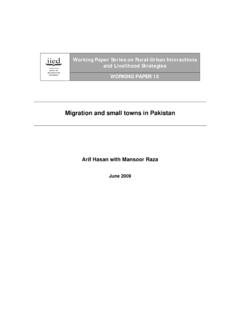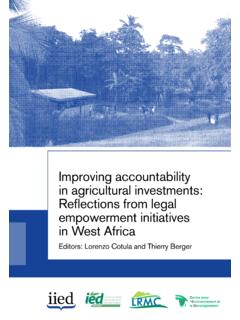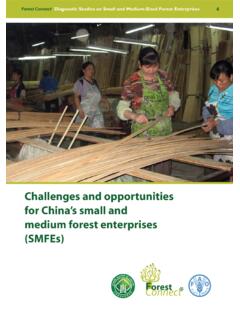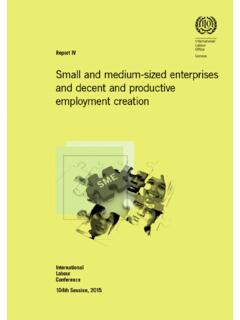Transcription of Small and Medium Sized Enterprises (SMEs) and Corporate ...
1 1 Small and Medium - Sized Enterprises (SMEs) and Corporate Social Responsibility: A Discussion Paper1 June 2005 Contents 1. Introduction .. 1 2. SMEs and sustainable development .. 2 3. SMEs and Corporate Social Responsibility .. 3 Existing approaches to CSR and SMEs .. 3 Creating a business case for CSR among SMEs .. 5 4. Bringing the two agendas together: Future lines of enquiry .. 7 Bottom of the Pyramid .. 7 Clusters and linkages .. 8 Bringing CSR into business support services and 9 5. Conclusion: Bringing SMEs to the heart of the CSR agenda .. 9 Bibliography .. 11 1. Introduction From an individual street hawker to a complex multinational enterprise, every business entity has its stakeholders and its impacts on society, both positive and negative.
2 The concept of Corporate social responsibility (CSR), broadly defined as the overall contribution of a business to sustainable development (SD), should therefore be equally valid for large and Small Enterprises . But when CSR is discussed in policy circles, academia, the media, and wider civil society, the focus tends to be on the largest companies. Small - and Medium - Sized Enterprises (SMEs) are often overlooked. Some related policy debates, however, do address SMEs. Programmes on enterprise development and business development services (BDS) often focus particularly on ensuring an enabling environment for SMEs and microenterprises. The justification is that a vibrant SME sector can form the bedrock on which all economic activity is built, and that SMEs can be the mainstay of an economy, particularly in terms of employment.
3 This paper seeks to examine this apparent dissonance between the SME/CSR agenda and the SME/SD agenda. We explore future lines of enquiry that might help to reduce this dissonance. In doing so, we take the position that CSR is a useful entry point from which to consider SMEs. We assume that there remains scope for reforming the CSR agenda to be more relevant to SMEs, and we explore how this might be Before going any further, it is important to make a note on terminology. Although the term SME is frequently used, it is seldom defined yet this is essential to understand the significance of the sector, and the implications for and limitations of CSR in relation to it. What constitutes a Small , Medium or large company is by no means clear or uniform, even within individual countries.
4 The SME and micro-enterprise (ME) sector encompasses a very 1 Written by Tom Fox of IIED. The paper also draws on a joint paper produced with AICC, DA, IISD, IUCN and RIDES as part of a collaborative project addressing the implications of CSR standardisation (AICC et al., 2004), and discussions in an internal IIED workshop on SMEs and sustainable development, held November 2004. 2 This position does need to be revisited in any further work on CSR and SMEs the orientation of the existing CSR agenda towards large companies may be so firmly established that it makes more sense to bypass it completely, and use a different approach to consider the needs of SMEs and how their contribution to SD can be enhanced. 2broad range of firms, from established traditional family businesses employing over a hundred people to survivalist self-employed people working in informal micro- Enterprises .
5 While the upper end of the range is comparable across developed and developing countries, SMEs in the latter are concentrated at the lowest end. The picture is blurred further by the distinction between the formal and informal sectors. The term SME usually refers only to firms operating within the formal (legally registered) economy, and attempts to relate the CSR agenda to SMEs are likely to be restricted to these Enterprises . Micro Enterprises may be in either the formal or informal sector. However, it is not unusual for statistics to group these Enterprises together, where data is available. The informal sector is particularly significant in many developing countries. Given this variation between types of SME, and the difficulties of classification, we must draw policy conclusions with some caution.
6 2. SMEs and sustainable development SMEs are the lifeblood of most economies. On average, they represent over 90% of Enterprises and account for 50-60% of employment at a national level (Luetkenhorst (2004)). Luetkenhorst (2004) argues that SMEs are particularly important in supporting economic growth and livelihoods in developing countries, because they (inter alia): tend to use more labour-intensive production processes than large Enterprises , boosting employment and leading to more equitable income distribution; provide livelihood opportunities through simple, value-adding processing activities in agriculturally-based economies; nurture entrepreneurship; and support the building up of systemic productive capacities and the creation of resilient economic systems, through linkages between Small and large Enterprises .
7 Evidence from elsewhere on the relationship between the relative size of the SME sector, economic growth and poverty is more equivocal. Using a sample of 76 countries, Beck et al. (2003) find a strong association between the importance of SMEs and GDP per capita growth, but the data does not support the hypothesis that SMEs exert a causal impact on growth. Neither do they find any positive evidence that a larger SME sector reduces poverty. Beyond hard economics, whether SMEs are inherently more socially beneficial than larger companies is a matter of opinion. They are perhaps more likely to contribute to social capital in the localities of their operations, as they are more likely to be embedded in their But they may also be less likely to be subject to rigorous inspections in relation to labour or environmental standards.
8 In either case, there will be exceptions, and it may be that these arguments run more closely along the dividing line between the formal and informal economy than according to size alone. These debates are somewhat academic. In pragmatic terms, it is clear that SMEs as they stand are a major economic force, upon which large numbers of people in developing countries depend for their livelihoods. At the very least then, CSR practices should be shaped in a way that does not adversely affect the economic viability of SMEs in developing countries. As we will discuss below, one of the most challenging critiques of CSR tools, particularly codes of conduct and supply chain standards, is that they can exclude SMEs in developing countries from lucrative markets, thus harming livelihoods.
9 But the SME/SD agenda takes us one step beyond this. As would be expected from such a large body of economic actors, the cumulative social and environmental impacts of SMEs are highly significant, even though their individual impacts are Small . This is not simply due to the large number of Enterprises and their overall economic significance, but also because SMEs are often over-represented in industrial sectors with high environmental impacts, and 3 MacQueen (2005) sets out this case in some depth. 3because they may not be subject to the same regulatory and enforcement processes that can mitigate the negative impacts of large companies. There is therefore the potential for significant progress towards sustainable development if SMEs social and environmental performance could be ratcheted up.
10 This logic leads to two conclusions in relation to CSR and SMEs. Firstly, that it makes sense to identify existing CSR-related incentives for SMEs to adopt higher social and environmental standards, while ensuring that flanking measures are in place to assist in this transition and to protect livelihoods. And secondly, that we should look for new ways to make CSR more relevant to SMEs. We return to this below. 3. SMEs and Corporate Social Responsibility As noted above, we can view CSR as the overall contribution of business to sustainable Hence, the CSR agenda relates to the theory and practice of attempts to maximise the positive contributions of businesses to sustainable development, while minimising their negative impacts.



















